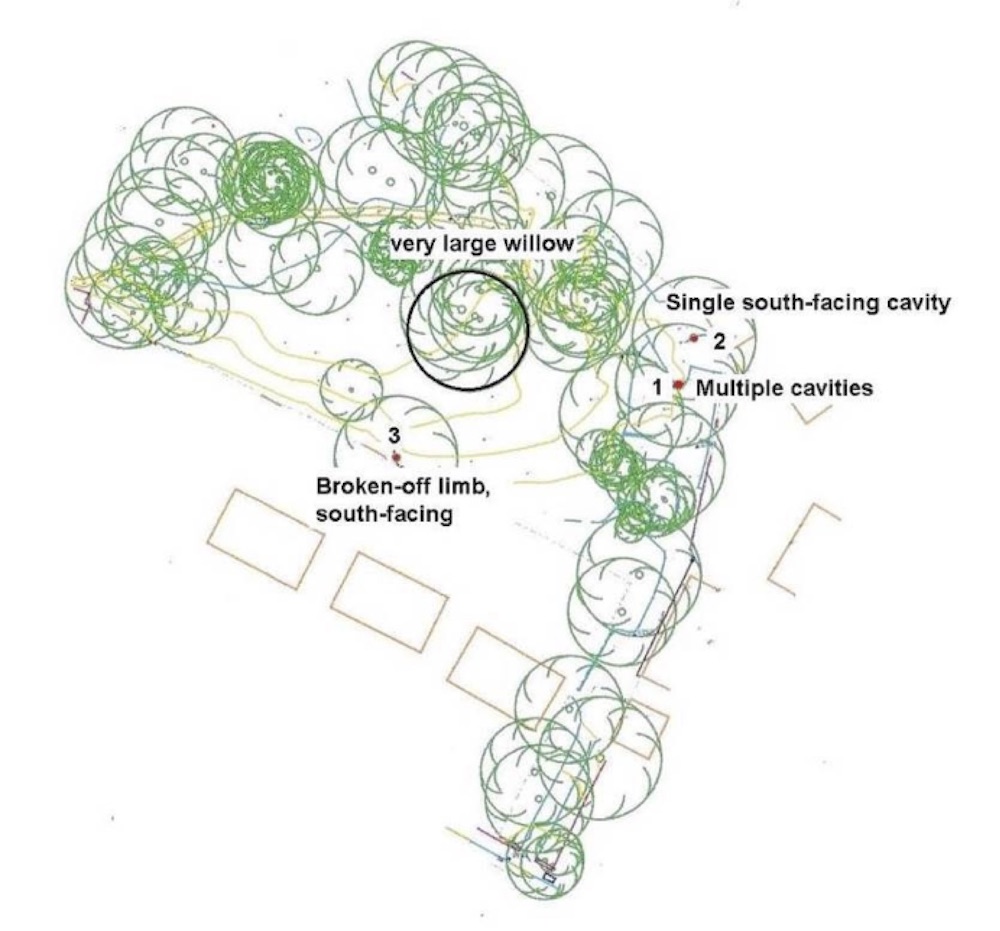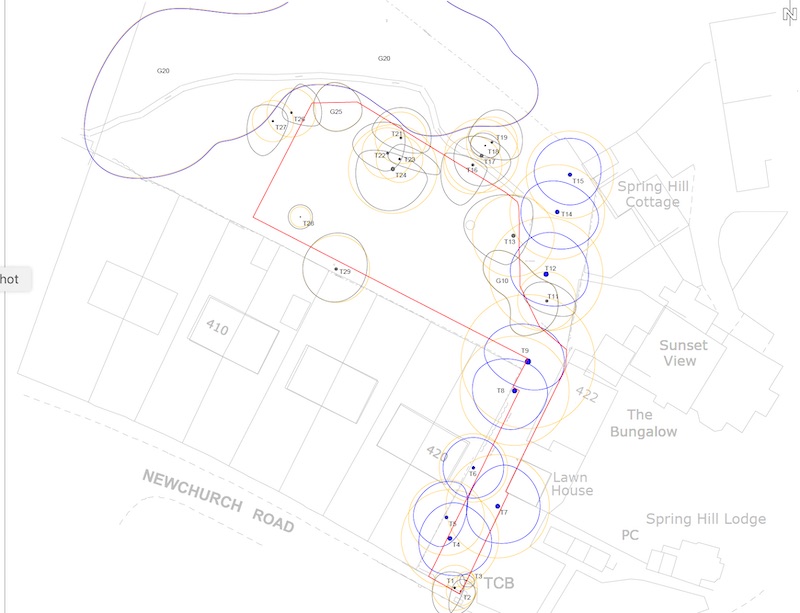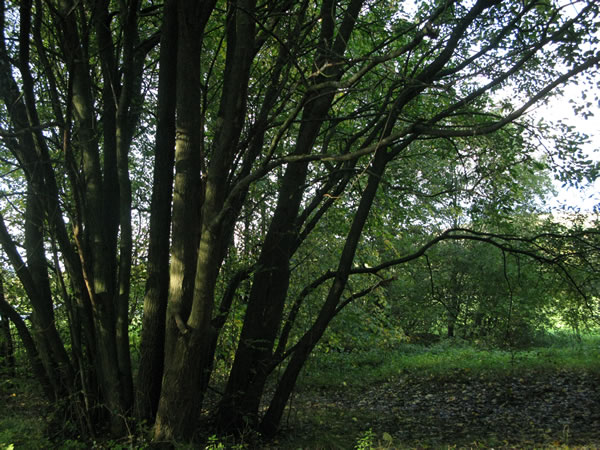December 2019
Bats
31/12/19 22:46
The possibility of trees on the lane/field being bat roosting sites was also considered and the land was surveyed to consider this. As this survey was performed in daylight in October 2018 the chances of actually seeing a bat were minimal and this was acknowledged in the report. The survey rather concentrated on which trees had potential roosting sites.
I have undertaken daubenton bat surveys on the river Irwell for the Bat Conservation Trust for a number of years now, though my bat detection skills are not brilliant. I have also wandered along the lane and through the field then over above Marl Pits from time to time and noted a number of species, though the only ones on the lane itself are pipistrelles and soprano pipistrelles. It is also fun to sit in the garden on a summer evening and watch the bats fly over Springhill House from the direction of Sion, so I wouldn't be surprised if they roosted there though have never been looking.
The bat survey described three trees which had roosting potential:
A large ash on the north side of the proposed boundary of the bungalow, with three cavity openings in the main trunk up to about 5 m above ground level. This is probably T14.
A small-leaved lime just north of this ash. It has a single opening on the south side at about 3.5m and is T15.
Another ash, this time close to the southern boundary of the proposed bungalow at its eastern aspect with cavity on the southern side ta 4m above ground level. This is T29.
(for further details see the post 'lane/field trees' on 22/12/2019)

These are not trees which are directly threatened by the development, nevertheless the surveyor recommended that work be carried out outside winter to ensure any bats hibernating there are not disturbed.
I have undertaken daubenton bat surveys on the river Irwell for the Bat Conservation Trust for a number of years now, though my bat detection skills are not brilliant. I have also wandered along the lane and through the field then over above Marl Pits from time to time and noted a number of species, though the only ones on the lane itself are pipistrelles and soprano pipistrelles. It is also fun to sit in the garden on a summer evening and watch the bats fly over Springhill House from the direction of Sion, so I wouldn't be surprised if they roosted there though have never been looking.
The bat survey described three trees which had roosting potential:
A large ash on the north side of the proposed boundary of the bungalow, with three cavity openings in the main trunk up to about 5 m above ground level. This is probably T14.
A small-leaved lime just north of this ash. It has a single opening on the south side at about 3.5m and is T15.
Another ash, this time close to the southern boundary of the proposed bungalow at its eastern aspect with cavity on the southern side ta 4m above ground level. This is T29.
(for further details see the post 'lane/field trees' on 22/12/2019)

These are not trees which are directly threatened by the development, nevertheless the surveyor recommended that work be carried out outside winter to ensure any bats hibernating there are not disturbed.
Lane/field trees
22/12/19 22:54
The various ecology reports also resulted in a number of tree inventories of the lane and field. Collating these together we seem to have:

Blue trees are category B and grey ones category C. There are no category A (good) or U (unsuitable for retention) trees on the lane. The yellow circles indicate root protection areas.
So what are they then?
T1 - semi-mature Elm
T2 - young Ash
T3 - semi-mature Elder
T4 - early mature Ash
T5 - early mature Ash
T6 - semi-mature Ash
T7 - early mature Sycamore
T8 - mature Sycamore
T9 - mature Sycamore
G10 - young to semi-mature sycamore and elm
T11 - early mature Elm
T12 - marly mature Ash
T13 - semi-mature Ash
T14 - early mature Elm
T15 - marly mature Common Lime
T16 - semi-mature Ash
T17 - semi-mature Ash
T18 - semi-mature Ash
T19 - semi-mature Ash
G20 - semi-mature to early mature Ash and Sycamore
T21 - semi-mature Ash
T22 - semi-mature Ash
T 23 - semi-mature Ash
T24 - semi-mature Ash
G25 - young Ash
T26 - semi-mature Goat Willow
T27 - semi-mature Goat Willow
T28 - semi-mature Fir
T29 - semi-mature Ash
The trees currently marked for felling if the bungalow goes ahead are:
G10 - young to semi-mature sycamore and elm
T11 -early mature Elm
T16 - semi-mature Ash
T21 - semi-mature Ash
T22 - semi-mature Ash
T23 - semi-mature Ash
T24 -semi-mature Ash
T28 -semi-mature Fir
T29 - semi-mature Ash
We will see.

Blue trees are category B and grey ones category C. There are no category A (good) or U (unsuitable for retention) trees on the lane. The yellow circles indicate root protection areas.
So what are they then?
T1 - semi-mature Elm
T2 - young Ash
T3 - semi-mature Elder
T4 - early mature Ash
T5 - early mature Ash
T6 - semi-mature Ash
T7 - early mature Sycamore
T8 - mature Sycamore
T9 - mature Sycamore
G10 - young to semi-mature sycamore and elm
T11 - early mature Elm
T12 - marly mature Ash
T13 - semi-mature Ash
T14 - early mature Elm
T15 - marly mature Common Lime
T16 - semi-mature Ash
T17 - semi-mature Ash
T18 - semi-mature Ash
T19 - semi-mature Ash
G20 - semi-mature to early mature Ash and Sycamore
T21 - semi-mature Ash
T22 - semi-mature Ash
T 23 - semi-mature Ash
T24 - semi-mature Ash
G25 - young Ash
T26 - semi-mature Goat Willow
T27 - semi-mature Goat Willow
T28 - semi-mature Fir
T29 - semi-mature Ash
The trees currently marked for felling if the bungalow goes ahead are:
G10 - young to semi-mature sycamore and elm
T11 -early mature Elm
T16 - semi-mature Ash
T21 - semi-mature Ash
T22 - semi-mature Ash
T23 - semi-mature Ash
T24 -semi-mature Ash
T28 -semi-mature Fir
T29 - semi-mature Ash
We will see.
Veteran tree
14/12/19 20:10
The process of granting planning permission for the proposed bungalow on the field included a number of objections on ecological grounds. These gave rise to a number of reports considering a number of issues with a variety of opinions, some of which will be considered in the next few posts. We start with the 'veteran tree'.
The question of a 'veteran tree' arose from a passing comment in the bat survey which stated that one of the proposed trees in the curtilage of the bungalow was a 'veteran tree' and so subject to the restrictions and considerations protecting such trees. This tree was identified as a coppiced willow. The formal tree survey however identified it as an ash and a third opinion concurred, adding that in their opinion it did not show any features of being a veteran tree.

(picture mine)
Helpfully, the term 'veteran tree' appears not to have a precise definition. The Ancient Tree Forum defines it thus:
'a veteran tree can be any age, but it is a tree which shows ancient characteristics such as [see below]. These may not just be due to age, but could result from natural damage, management, or the tree's environment. Ancient trees are all veterans, but not all veterans are ancient.'
Just to complicate things, the age of an ancient tree varies with the species but they share a set of common features:
And to confuse things further, they also identify a heritage tree (part of our history and culture) and a notable tree (of particular significance locally)
The Royal Forestry Society also comment on the wide range of fauna and fungal bodies which can be supported by a veteran tree, due to the long period of stability and continuity. They also often reflect historical management practices such as pollarding or coppicing.
The Woodland Trust has mapped three veteran trees in Rossendale, all on Burnley Road East. There are a number in Edenfield, which may reflect better registration in that area. Interestingly there is a notable Birch tree near Birch village outside Rochdale.
The question of a 'veteran tree' arose from a passing comment in the bat survey which stated that one of the proposed trees in the curtilage of the bungalow was a 'veteran tree' and so subject to the restrictions and considerations protecting such trees. This tree was identified as a coppiced willow. The formal tree survey however identified it as an ash and a third opinion concurred, adding that in their opinion it did not show any features of being a veteran tree.

(picture mine)
Helpfully, the term 'veteran tree' appears not to have a precise definition. The Ancient Tree Forum defines it thus:
'a veteran tree can be any age, but it is a tree which shows ancient characteristics such as [see below]. These may not just be due to age, but could result from natural damage, management, or the tree's environment. Ancient trees are all veterans, but not all veterans are ancient.'
Just to complicate things, the age of an ancient tree varies with the species but they share a set of common features:
- a low, fat and squat shape, because the crown has retrenched through age
- a wide trunk compared with others of the same species
- hollowing of the trunk (not always visible)
And to confuse things further, they also identify a heritage tree (part of our history and culture) and a notable tree (of particular significance locally)
The Royal Forestry Society also comment on the wide range of fauna and fungal bodies which can be supported by a veteran tree, due to the long period of stability and continuity. They also often reflect historical management practices such as pollarding or coppicing.
The Woodland Trust has mapped three veteran trees in Rossendale, all on Burnley Road East. There are a number in Edenfield, which may reflect better registration in that area. Interestingly there is a notable Birch tree near Birch village outside Rochdale.
Permission granted
01/12/19 21:47
The advert to sell the field for development in 2017 did not result in any sale but about a year later, Nov 2018, it became apparent that a couple were planning to buy the field to build a 7-bedroom bungalow for their family. The arguments raised to and fro but permission was granted in May 2019. Nothing has happened to date however.
The bungalow will be on the far south side of the field, quite close to the boundaries of the houses which front onto Newchurch Road. Access will be from Springhill Lane with a new vehicular entry to the field about 2/3 of the way up the lane on the left. Just where the wren nests.
It is unclear yet what that means for the variety of bird feeders on the trees on the lane, or for the birds which feed on them.
The process of getting planning permission included a number of reports including ecological surveys. These were interesting reading, added to my understanding of the natural history of the lane and were not without controversy. More on these later.
The bungalow will be on the far south side of the field, quite close to the boundaries of the houses which front onto Newchurch Road. Access will be from Springhill Lane with a new vehicular entry to the field about 2/3 of the way up the lane on the left. Just where the wren nests.
It is unclear yet what that means for the variety of bird feeders on the trees on the lane, or for the birds which feed on them.
The process of getting planning permission included a number of reports including ecological surveys. These were interesting reading, added to my understanding of the natural history of the lane and were not without controversy. More on these later.




